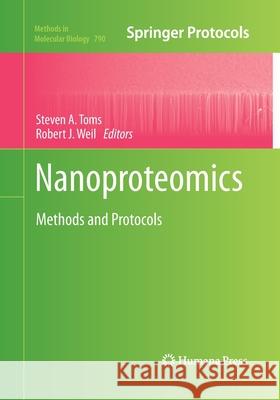Nanoproteomics: Methods and Protocols » książka



Nanoproteomics: Methods and Protocols
ISBN-13: 9781493957996 / Angielski / Miękka / 2016 / 322 str.
Nanoproteomics: Methods and Protocols
ISBN-13: 9781493957996 / Angielski / Miękka / 2016 / 322 str.
(netto: 557,20 VAT: 5%)
Najniższa cena z 30 dni: 559,02
ok. 22 dni roboczych.
Darmowa dostawa!
This volume organizes and collects technical advances from leaders in the field to make laboratory protocols more readily available and understandable to those who are attempting to incorporate nanotechnologic techniques into their proteomic research.
Part I: Preliminary Sample Preparation
1. MALDI-TOF Serum Profiling Using Semi-Automated Serum Peptide Capture with Magnetic Reversed Phase (C18) Beads
Jaco C. Knol and Connie R. Jimenez
2. Proteomics of Epithelial Lining Fluid Obtained by Bronchoscopic Microprobe Sampling
Lorenza Franciosi, Natalia Govorukhina, Nick ten Hacken, Dirkje Postma, and Rainer Bischoff
Part II: Nanoscale Separation
3. Protein Identification Using Nano-HPLC-MS: ESI-MS and MALDI-MS Interfaces
Rui Vitorino, Jana Krenkova, Frantisek Foret, Pedro Domingues, and Francisco Amado
4. Three Dimensional Peptide Fractionation for Highly Sensitive Nanoscale LC-Based Shotgun Proteomic Analysis of Complex Protein Mixtures
Sricharan Bandhakavi, Todd W. Markowski, Hongwei Xie, and Timothy J. Griffin
5. Nanospray Ion Mobility Mass Spectrometry of Selected High Mass Species
Iain Campuzano and Kevin Giles
6. Nanoelectrospray-MSn of Native and Permethylated Glycans
Christina Bleckmann, Hildegard Geyer, and Rudolf Geyer
7. N-linked Global Glycan Profiling by NanoLC Mass Spectrometry
Michael S. Bereman and David C. Muddiman
8. Applications of Nanoscale Liquid Chromatography Coupled to Tandem Mass Spectrometry in Quantitative Studies of Protein Expression, Protein-Protein Interaction, and Protein Phosphorylation
Metodi V. Metodiev
9. Nano LC-MS/MS: A Robust Setup for Proteomic Analysis
Marco Gaspari and Giovanni Cuda
10. Nanofluidic Devices for Rapid Continuous-Flow Bioseparation
Pan Mao and Jianping Fu
11. Quantifying Attomole Amounts of Proteins from Complex Samples by Nano-LC and Selected Reaction Monitoring (SRM)
Thomas Fröhlich and Georg J. Arnold
Part III: Nanomaterials: Nanostructured Surfaces
12. A Sample Preparation Method for Gold Nanoparticle-Assisted Laser Desorption/Ionization Time-of-Flight Mass Spectrometry
Yen-Hsiu Lin and Wei-Lung Tseng
13. Nanostructured TiO2 Thin Films for Phosphoproteomics Studies with MALDI Mass Spectrometry
Federico Torta, Matteo Fusi, Carlo S.Casari, Andrea Li Bassi, and Angela Bachi
14. Nanofilament Silicon for Matrix-Free Laser Desorption/Ionization Mass Spectrometry
Chia-Wen Tsao and Don L. DeVoe
15. Protein Nanoarrays for High Resolution Patterning of Bacteria on Gold Surfaces
Cait Costello, Jan-Ulrich Kreft, Christopher M. Thomas, and Paula M. Mendes
Part IV: Nanomaterials: Nanoscale Tools for Proteomic Discovery
16. Engineered Multifunctional Nanotools for Biological Applications
Mohammed Ibrahim Shukoor, Muhammad Nawaz Tahir, Thomas Schladt, Wolfgang Tremel, Zhiqun Zhang, Kevin K. Wang, and Firas Kobeissy
17. The Selective Capture of Phosphopeptides by Zirconium Phosphonate-Modified Magnetic Nanoparticles
Liang Zhao, Ren’an Wu, and Hanfa Zou
18. Nanowire Biosensors for Label-Free, Real-Time, Ultrasensitive Protein Detection
Gengfeng Zheng and Charles M. Lieber
19. Generation of Anti-Infectome/Anti-Proteome Nanobodies
Gholamreza Hassanzadeh-Ghassabeh, Dirk Saerens, and Serge Muyldermans
Part V: Nanotechnology: Techniques in Proteomics--Potential Application for Health & Disease
20. Isolation, Propagation, and Analysis of Biological Nanoparticles
Michael P. Linnes, Farooq A. Shiekh, Larry W. Hunter, Virginia M. Miller, and John C. Lieske
21. Functionalized Soluble Nanopolymers for Phosphoproteome Analysis
Anton Iliuk, Keerthi Jayasundera, Rachel Schluttenhofer, and W. Andy Tao
22. Elucidating Structural Dynamics of Integral Membrane Proteins on Native Cell Surface by Hydroxyl Radical Footprinting and NanoLC-MS/MS
Yi Zhu, Tiannan Guo, and Siu Kwan Sze
23. Application of Electrostatic Repulsion Hydrophilic Interaction Chromatography (ERLIC) to the Characterization of Proteome, Glycoproteome, and Phosphoproteome Using Nano LC-MS/MS
Piliang Hao, Huoming Zhang, and Siu Kwan Sze
As two relatively new fields of study, proteomics and nanotechnology have developed in parallel with each other to allow an increased precision in the identification of post-translational protein modifications as well as to provide a more automated isolation and detection of rare proteins in both serum and tissues. The Nanoproteomics: Methods and Protocols volume organizes and collects technical advances from leaders in the field to make laboratory protocols more readily available and understandable to those who are attempting to incorporate nanotechnologic techniques into their proteomic research. Conveniently divided into five sections, this detailed volume covers preliminary sample preparation, nanoscale fluidic devices and methods, nanostructured surfaces and nanomaterials, and nanoproteomic techniques to detect and understand protein and proteomic alterations specific to human pathology. Written in the highly successful series entitled Methods in Molecular Biology™, these chapters include introductions to their respective topics, lists of the necessary materials and reagents, step-by-step laboratory protocols that are readily reproducible, and tips on troubleshooting and avoiding known pitfalls.
Convenient and authoritative, Nanoproteomics: Methods and Protocols offers key procedures that are culled from the laboratories of leaders in the field of nanoproteomics with the aim of helping researchers in their standardization and proliferation of protocols that will lead to a more wide scale adoption and smoother progress in this vital field.
1997-2025 DolnySlask.com Agencja Internetowa
KrainaKsiazek.PL - Księgarnia Internetowa









